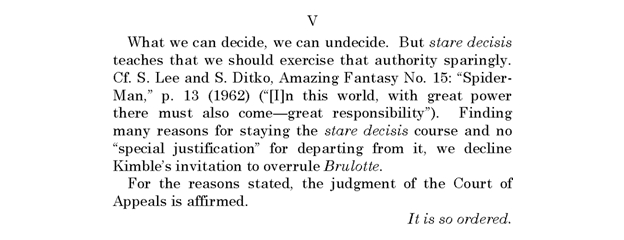Around here, the reaction to President Obama’s speech at the Catholic Health Association conference a couple of days ago, where the President called out the “cynicism” underlying the petitioners’ claims in King v. Burwell – being the second attempt by die-hard Obamacare opponents to recruit five willing executioners on the Supreme Court – was nothing short of hysterical. In addition to the usual attacks on the President’s disrespect for the rule of law and Nietzschean impulses, there was renewed finger-wagging to the effect that the language in dispute is not a “a drafting error or a typo” but rather stands on its own as wholly dispositive of the matter at hand.
So, while we wait for the ruling to come down, let’s read the amicus curiae brief filed by Eskridge, et al., and see statutory interpretation done as God and Oliver Wendell Holmes intended. The introduction and summary of argument:
The court of appeals held that the Patient Protection and Affordable Care Act (ACA) does not prohibit the Internal Revenue Service (IRS) from providing tax credits to individuals who purchase health insurance on exchanges created by the Department of Health and Human Services (HHS). Petitioners challenge that conclusion on the sole ground that seven words in 26 U.S.C. § 36B – “established by the State under section 1311” – foreclose tax credits on HHS-created exchanges. The text, they say, is clear, so by holding otherwise, the court below elevated statutory purpose over statutory text.
But this is not, as Petitioners suggest, a case about textualism vs. purposivism. It is a case about good textual analysis vs. bad textual analysis. Textualism does not require courts to read statutory provisions in a vacuum. To the contrary, it is a “fundamental canon of statutory construction that the words of a statute must be read in their context and with a view to their place in the overall statutory scheme.” FDA v. Brown & Williamson Tobacco Corp., 529 U.S. 120, 133 (2000) (internal quotation marks omitted). By focusing exclusively on Section 36B’s seven words in isolation, Petitioners violate textualism’s core tenets and adopt an interpretation that would nullify the Act as a whole.
Modern textualism developed as a response to purposivism, which held that the letter of the law must yield to legislative “intent.” A search for legislative intent, textualists have explained, violates the constitutionally prescribed process of bicameralism and presentment: The only “law” to interpret is the text of a statute passed by both houses of Congress and signed by the president. By combing the legislative history for indicia of legislative intent, moreover, purposivist analysis risks substituting judicial judgment for the judgment of Congress. Thus, by focusing on the text of a statute – rather than on ethereal notions of legislative “intent” – textualism cabins judicial discretion, respects legislative supremacy in the policymaking process, and renders the interpretive process more predictable.
But textualism is not hyperliteralism, and textualists do not read the words of a statute in a vacuum. To the contrary, “reasonable statutory interpretation must account for both ‘the specific context in which … language is used’ and ‘the broader context of the statute as a whole.’” Utility Air Regulatory Grp. v. EPA, 134 S. Ct. 2427, 2442 (2014) (quoting Robinson v. Shell Oil Co., 519 U.S. 337, 341 (1997)). Thus, a statutory phrase that has one apparent meaning when read in isolation may have a different meaning when read in the context of the statute as a whole.
See more…

